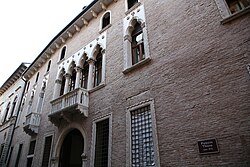
Vicenza is a city renowned for its wealth of palaces and residences, which reflect the diverse artistic, architectural, and urban phases of its history. These structures are particularly associated with the work of the 16th-century architect Andrea Palladio.
Contents
- UNESCO World Heritage designation
- A
- Angaran palaces
- Arnaldi palaces
- B
- Bissari buildings
- Breganze palaces
- C
- Caldogno palaces
- Capra palaces
- D
- E
- F
- G
- Garzadori palaces
- Gualdi palaces
- L
- M
- N
- O
- P
- Pagello palaces
- Piovene palaces
- Porto palaces and houses
- Q
- R
- S
- Sesso palaces
- T
- Thiene palaces
- Trento palaces
- Trissino palaces and houses
- V
- Valmarana palaces and houses
- Z
- See also
- References
- Bibliography
- External links
This page provides an alphabetical list of Vicenza’s civic buildings. It includes:
- Identification of each building, including its precise name, address, and geographic coordinates.
- Brief historical and artistic details.
- Indication of buildings no longer extant (in italics).









































